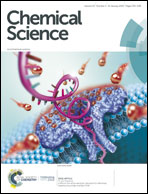Mobility of hydrated alkali metal ions in metallosupramolecular ionic crystals†
Abstract
The design and creation of ionic crystals that show high mobility of ionic species in the solid state has long been a research topic of considerable attention not only due to the practical applications of these materials but also due to the correlation of such ionic species with ion-transport biological systems. In this work, we report the mobility of alkali metal ions (M = Li+, Na+, K+) in the ionic crystals M6[Rh4Zn4O (L-cysteinate)12]·nH2O (M6[1]·nH2O). In M6[1]·nH2O, alkali metal ions are distributed in a disordered manner, together with a number of water molecules, within a rigid hydrogen-bonded framework of anionic clusters of [1]6−. The alternating current conductivities of M6[1]·nH2O in the solid state increase in the order of Li6[1]·nH2O < Na6[1]·nH2O < K6[1]·nH2O, which is opposite to the order of the naked ionic radii. The conductivities reach the superionic level of σ = 1.3 × 10−2 S cm−1 at 300 K for a single crystal of K6[1]·nH2O. These results reflect the high mobility of hydrated alkali metal ions in the crystal lattice of M6[1]·nH2O, which is supported by solid-state NMR spectroscopy, together with ion diffusion experiments in the solid state. The high mobility leads to quick exchange of K+ ions in K6[1]·nH2O with Li+ and Na+ ions with retention of single crystallinity.



 Please wait while we load your content...
Please wait while we load your content...